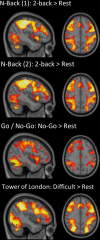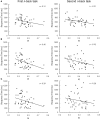Executive functions and prefrontal cortex: a matter of persistence?
- PMID: 21286223
- PMCID: PMC3031025
- DOI: 10.3389/fnsys.2011.00003
Executive functions and prefrontal cortex: a matter of persistence?
Abstract
Executive function is thought to originates from the dynamics of frontal cortical networks. We examined the dynamic properties of the blood oxygen level dependent time-series measured with functional MRI (fMRI) within the prefrontal cortex (PFC) to test the hypothesis that temporally persistent neural activity underlies performance in three tasks of executive function. A numerical estimate of signal persistence, the Hurst exponent, postulated to represent the coherent firing of cortical networks, was determined and correlated with task performance. Increasing persistence in the lateral PFC was shown to correlate with improved performance during an n-back task. Conversely, we observed a correlation between persistence and increasing commission error - indicating a failure to inhibit a prepotent response - during a Go/No-Go task. We propose that persistence within the PFC reflects dynamic network formation and these findings underline the importance of frequency analysis of fMRI time-series in the study of executive functions.
Keywords: BOLD; Hurst exponent; executive function; functional MRI; networks; persistence; prefrontal cortex.
Figures





References
-
- Anderson C. M., Lowen S. B., Renshaw P. F. (2006). Emotional task-dependent low-frequency fluctuations and methylphenidate: wavelet scaling analysis of 1/f-type fluctuations in fMRI of the cerebellar vermis. J. Neurosci. Methods 151, 52–61 - PubMed
-
- Apud J. A., Mattay V., Chen J., Kolachana B. S., Callicott J. H., Rasetti R., Alce G., Iudicello J. E., Akbar N., Egan M. F., Goldberg T. E., Weinberger D. R. (2007). Tolcapone improves cognition and cortical information processing in normal human subjects. Neuropsychopharmacology 32, 1011–102010.1038/sj.npp.1301227 - DOI - PubMed
-
- Beran J. (1994). Statistics for Long-Memory Processes. New York: Chapman & Hall
Grants and funding
LinkOut - more resources
Full Text Sources
Miscellaneous

